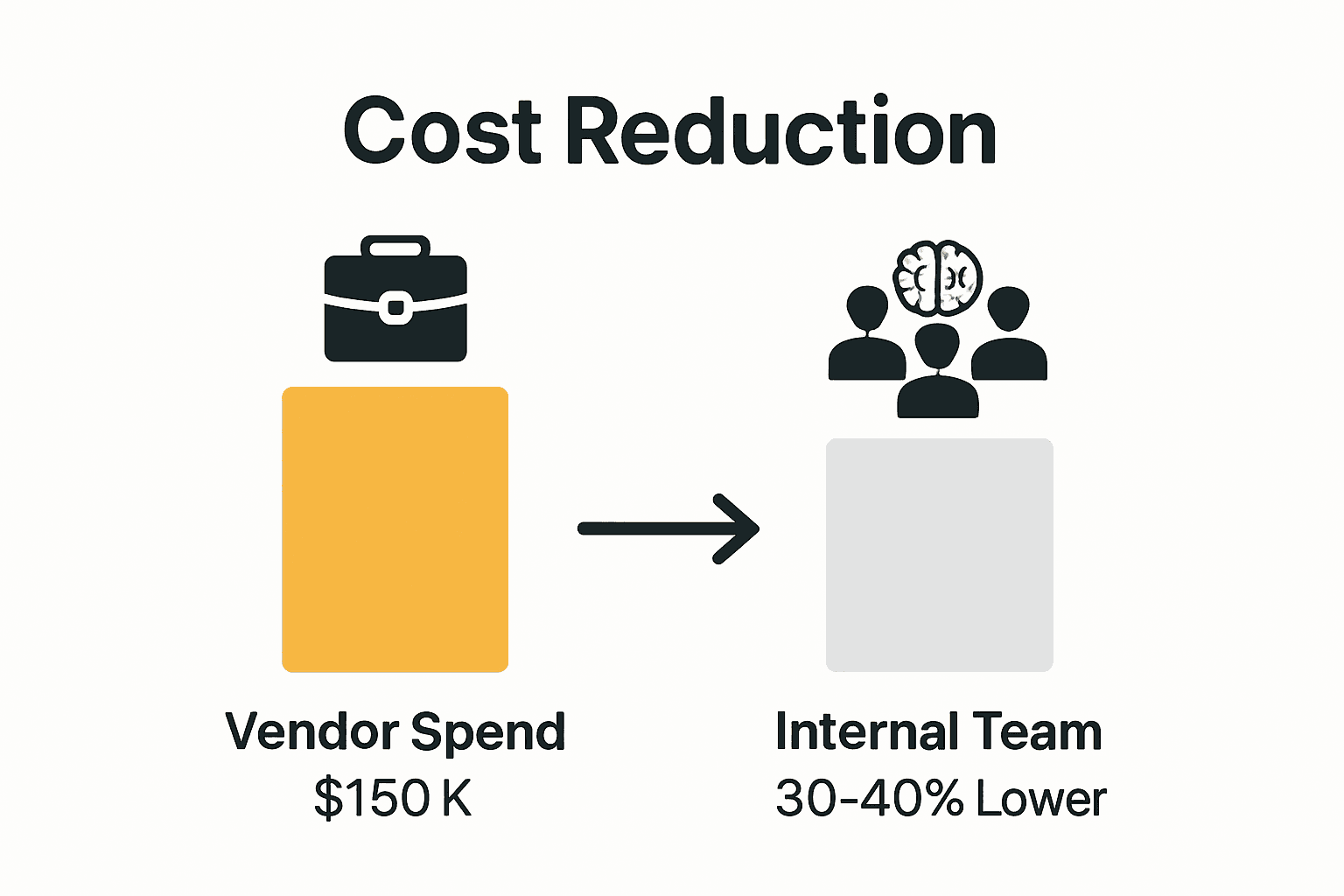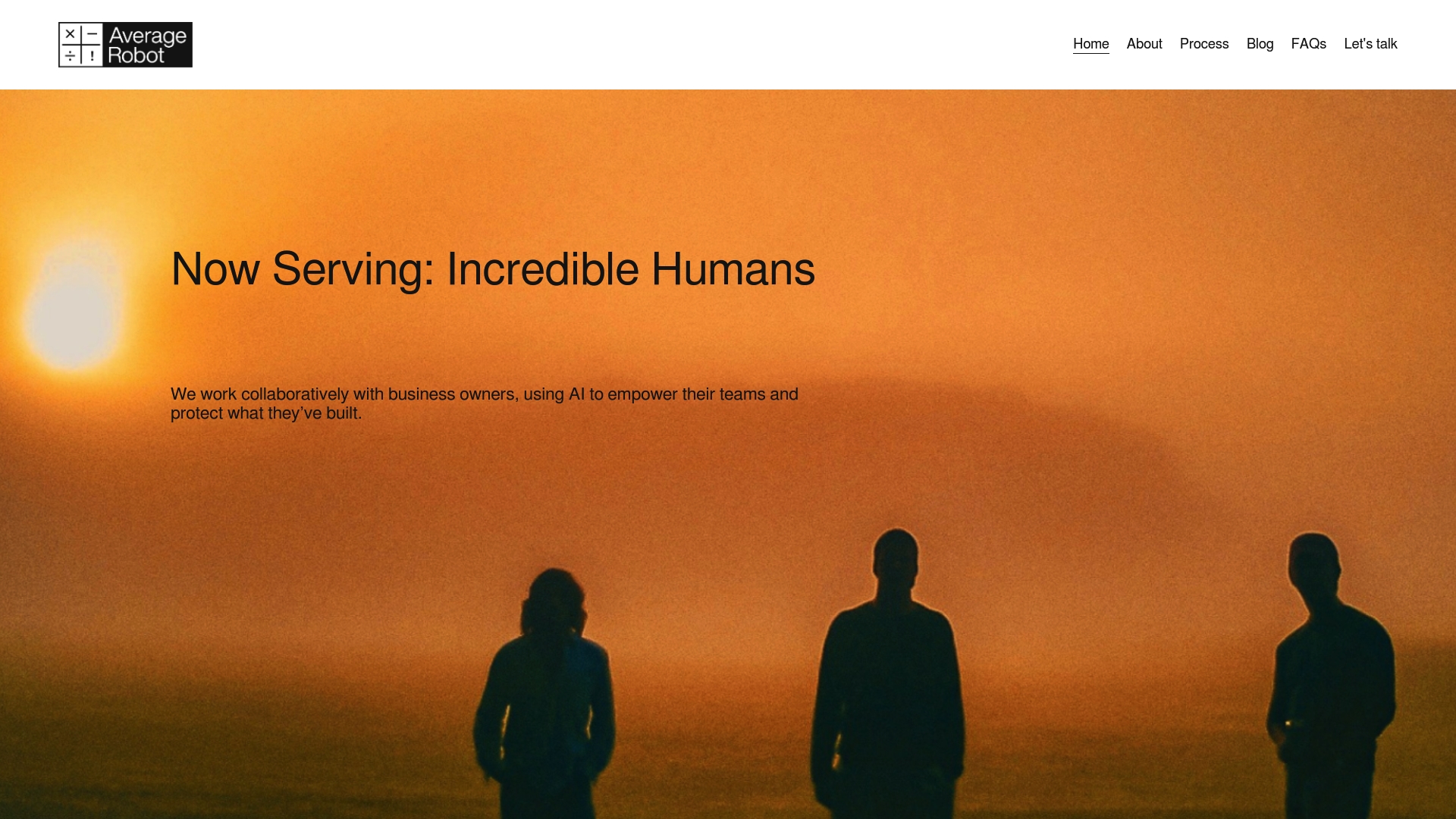Are You Overpaying for Work Your Team Could Own?

Did you know that many regional businesses pour up to $150,000 every month into vendor services, often without clear returns? This level of spending can quietly eat away at profits while stalling internal growth. Understanding how overpaid outsourcing and complex vendor relationships impact your bottom line helps you spot where valuable dollars slip away—and highlights pathways to regain control, improve margins, and empower your own teams for long-term success.
Key Takeaways
| Point | Details |
|---|---|
| Understanding Overpaid Outsourcing | Regional businesses often face vendor dependencies that lead to significant financial waste, consuming up to 40% of their external vendor budget on unnecessary outsourcing. |
| Identifying Hidden Costs | Vendor relationships across various categories can introduce considerable hidden costs, eroding operational budgets and hindering team capability development. |
| Emphasizing AI-Enabled Internal Teams | Investing in AI integration can transform internal teams, reducing reliance on expensive external vendors by up to 40%, while enhancing internal competencies. |
| Calculating Potential Savings | Implementing a vendor replacement strategy can yield substantial savings, potentially reclaiming $450K-$600K annually by rechanneling funds to internal development. |
Table of Contents
- Defining Overpaid Outsourcing In Regional Business
- Multiple Vendor Categories And Hidden Costs
- How Vendor Dependency Undermines Margins
- Building Internal Capability With Ai-Enabled Teams
- Calculating Savings: Vendor Replacement Impact
Defining Overpaid Outsourcing in Regional Business
Outsourcing isn’t just about hiring external talent—it’s about understanding the true cost of vendor dependency for regional businesses spending $50K-$150K monthly across marketing, operations, and strategic functions. Overpaid outsourcing represents those vendor relationships where businesses consistently pay premium rates for work their internal teams could potentially manage with the right support and tools.
For a typical $40-75M regional business in the Midwest or Southeast, overpaid outsourcing manifests through several key indicators:
- Recurring monthly agency retainers exceeding $15K without clear ROI documentation
- Consultant contracts that persist for 12+ months without tangible organizational capability transfer
- Marketing, creative, and strategic vendor relationships that charge premium rates while delivering minimal strategic insight
- Technology implementation partners who create dependency instead of building internal team competence
The financial impact is substantial. Most regional businesses discover they’re allocating 30-40% of their external vendor budget to services that could be internalized with strategic AI-enabled workflows and targeted team training. This isn’t about eliminating external expertise—it’s about transforming vendor relationships from perpetual dependencies to temporary capability accelerators that ultimately empower internal teams to drive sustainable business growth.
Multiple Vendor Categories and Hidden Costs
Beyond traditional marketing agencies, regional businesses frequently hemorrhage money across multiple vendor categories, creating a complex web of external dependencies that silently erode operational budgets. For businesses in the $40-75M revenue range, these vendor relationships span far beyond simple agency contracts, encompassing strategic consulting, technology implementation, creative services, operations management, and fractional executive support.
The typical vendor ecosystem for a regional business looks remarkably intricate:
Here’s a breakdown of typical vendor categories and their hidden costs:
| Vendor Category | Monthly Cost Range | Common Deliverables | Hidden Costs |
|---|---|---|---|
| Marketing Agencies | $15K-$35K | Digital ads Email campaigns Social media |
Premium fees Minimal strategic insight |
| Growth Consultants | $10K-$25K | Planning Positioning Revenue optimization |
Ongoing contracts Lack of skill transfer |
| Technology Partners | $20K-$50K | Software setup System integration Digital transformation |
Dependency on external support |
| Creative Services | $8K-$20K | Branding Design Content production |
Overpriced projects Redundant expenses |
| Fractional Executives | $5K-$15K | Part-time CMO/CTO Strategy leadership |
Temporary fixes Hindered internal growth |
- Marketing Agencies: Digital advertising, email campaigns, social media management ($15K-$35K monthly)
- Growth Consultants: Strategic planning, market positioning, revenue optimization ($10K-$25K monthly)
- Technology Partners: Software implementation, digital transformation, system integration ($20K-$50K monthly)
- Creative Services: Branding, design, content production ($8K-$20K monthly)
- Fractional Executives: Part-time CMO, CTO, strategy leadership ($5K-$15K monthly)
These vendor relationships aren’t just expensive—they create systemic organizational dependencies that prevent internal teams from developing critical capabilities. When businesses outsource strategic functions continuously, they’re essentially paying a recurring ‘expertise tax’ that can range from $50K to $150K monthly, effectively subsidizing external teams instead of building robust internal competencies. The hidden costs extend beyond direct financial expenditure, including reduced organizational agility, knowledge transfer limitations, and a perpetual state of reactive rather than proactive business management.

How Vendor Dependency Undermines Margins
For regional businesses in the $40-75M revenue range, vendor dependencies represent far more than just line-item expenses—they’re strategic profit erosion mechanisms that silently consume operational margins. When businesses continuously outsource critical functions, they’re not just paying for services, they’re surrendering potential internal growth and financial optimization opportunities.
The margin impact of persistent vendor relationships can be devastatingly precise:
- Direct Cost Impact: External vendors typically charge 30-50% premium over internal capability development costs
- Opportunity Cost: Internal team productivity and skill development are consistently deferred
- Strategic Overhead: Management time spent coordinating multiple vendor relationships reduces operational efficiency
- Knowledge Transfer Limitations: Continuous outsourcing prevents institutional learning and capability building
Most regional businesses discover they’re allocating between 15-25% of their annual revenue toward external vendors—a staggering figure that directly translates to reduced profitability. By maintaining these dependencies, organizations essentially trade long-term strategic advantage for short-term tactical convenience, creating a cycle where external expertise becomes a perpetual financial burden rather than a temporary capability accelerator.
The true cost isn’t just monetary; it’s the systematic erosion of internal team potential and organizational adaptability.
Building Internal Capability With AI-Enabled Teams
AI-enabled teams represent the future of organizational capability for regional businesses looking to break free from expensive vendor dependencies. Instead of continuously outsourcing critical functions, businesses can transform their internal teams into high-performance units that leverage artificial intelligence as a strategic multiplier, enabling them to accomplish sophisticated work traditionally reserved for external consultants and agencies.
The pathway to building these capabilities involves several strategic approaches:
- Skill Mapping: Identify current team capabilities and AI-augmentation potential
- Targeted Training: Develop AI literacy and practical implementation skills
For businesses in the $40-75M revenue range, understanding why teams need AI for success becomes crucial. By systematically integrating AI tools into existing workflows, organizations can dramatically reduce external spending while simultaneously increasing internal team competence and strategic flexibility.
The transformation isn’t about replacing people—it’s about empowering them. When internal teams learn to leverage AI as an intelligent assistant rather than a replacement, they can produce high-quality strategic work that previously required expensive external expertise. This approach typically reduces vendor costs by 30-40%, redirects funds toward team development, and creates a more agile, responsive organizational infrastructure that can rapidly adapt to changing business landscapes.
Calculating Savings: Vendor Replacement Impact
For regional businesses in the $40-75M revenue range, vendor replacement isn’t just a cost-cutting strategy—it’s a comprehensive financial transformation that can unlock substantial operational savings. The typical vendor ecosystem consumes between 15-25% of annual revenue, representing a significant opportunity for strategic reinvestment when systematically addressed.
A detailed vendor replacement impact analysis reveals multiple layers of financial optimization:
- Direct Cost Reduction: 30-40% immediate reduction in external vendor spending
- Indirect Savings: Reclaimed management time and reduced coordination overhead
- Strategic Reallocation: Funds redirected toward internal team development
- Long-Term Value: Increased organizational agility and capability retention
How to train teams on AI for effective adoption becomes critical in maximizing these financial gains. For a business currently spending $150K monthly on external vendors, a comprehensive vendor replacement strategy could translate to $450K-$600K in annual savings.

These aren’t theoretical numbers—they represent real financial transformation that directly impacts bottom-line performance, allowing businesses to reinvest in their core competencies, develop internal talent, and create a more responsive, efficient organizational infrastructure.
Cut Your Vendor Costs by 30-40%—Break the Dependency Trap Now
Are you tired of writing checks for $50K to $150K every month for agency retainers, consultants, tech partners, and fractional executives? If this article hit a nerve, you are not alone. For regional businesses like yours earning $40-75M, this is not just accounting. It is distraction from your craft. The problem is not just overpaying vendors, it is the hidden dependency tax draining your margins and forcing you to focus on managing outsiders, rather than your core business.
At Average Robot, we turn that narrative on its head. We help Midwest and Southeast companies eliminate the consultant crutch, cut outsourcing spend by $200K to $500K per year, and empower your team to own the work you have been paying for. We replace not just marketing agencies, but growth consultants, technology partners, creative vendors, and fractional leaders—all those categories that silently eat up your margins. Our approach starts with a free Vendor Dependency Assessment where we map your spend, identify the dollars you are wasting, and reveal exactly how much your team could handle with the right AI-enabled support. We also invite you to explore how teams can succeed with AI and how in-house training cuts costs.

Do not let another month slip by paying for work your team could own. Visit Average Robot now to book your free assessment. Calculate your potential $150K to $300K savings and take the first step toward breaking the dependency cycle for good. Get back to your passion—leave vendor management and tech headaches behind.
Frequently Asked Questions
What is overpaid outsourcing?
Overpaid outsourcing refers to vendor relationships where businesses consistently pay premium rates for services that their internal teams could potentially accomplish with the right support and tools.
How can I identify if my business is overpaying for outsourced services?
Look for indicators such as recurring high agency retainers without clear ROI, long-term consultant contracts with little capability transfer, and vendors charging premium rates with minimal strategic input.
What are the hidden costs of vendor dependencies?
Hidden costs include premium fees for services, deferred productivity and skill development of internal teams, coordination overhead, and limitations in knowledge transfer that prevent long-term organizational growth.
How can businesses reduce spending on external vendors?
By building AI-enabled internal teams through skill mapping and targeted training, businesses can accomplish critical functions in-house, significantly reducing reliance on costly external vendors and fostering internal capabilities.




